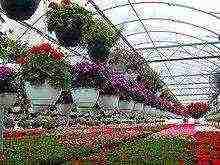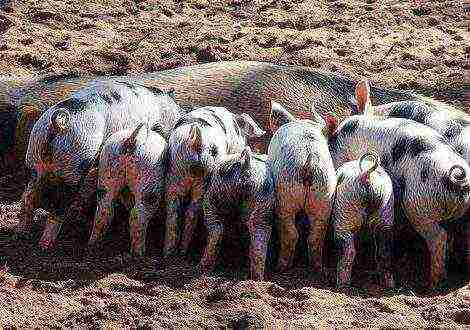Floriculture - the branch of plant growing, engaged in the selection and cultivation of flowering and other plants for decorative purposes: for cutting bouquets, creating greenhouses and green spaces in open ground, as well as for decorating residential and industrial premises.
Floriculture is one of the directions of decorative gardening. Floriculture is the cultivation of flower crops. They are grown to decorate parks, squares, gardens, various premises, to obtain cut flowers. Some plants are grown in open ground, others - in greenhouses, greenhouses, rooms. People began to engage in floriculture in ancient times.
History
In Moscow, Vladimir, Ryazan and other Russian principalities, gardening spread in the XII-XIII centuries, in Moscow and the Moscow region - at the beginning of the XIV century. The gardens were famous not only for the abundance of fruits, but also for the large number of fragrant flowers. Terry peonies, white and yellow lilies, “fragrant and burdock” carnations, scarlet mallow, aquilegia, azure and yellow violets, kalufer, iris, tulips, daffodils and many others were grown in the garden of the Moscow Kremlin and other gardens in Moscow in the 16th-17th centuries.
An important role in the development of ornamental gardening in the 19th century in Russia was played by the activities of the societies of gardening lovers that arose in Moscow (1853), St. Petersburg (1858) and their branches. The societies had nurseries and gardens, the societies organized exhibitions, held "public readings", created courses, published printed works, and awarded prizes and medals at exhibitions. The first international exhibitions were organized by the Russian Horticultural Society in St. Petersburg in 1869, 1883, 1899. All-Russian exhibitions were organized in 1890 and 1899.
In the first half of the XX century, domestic floriculture received unprecedented development. A large number of large flower farms and flower and ornamental nurseries were created, producing millions of plants for the improvement and decoration of the country's settlements. Much work on the creation of domestic varieties of floral and ornamental plants is being carried out in the Main Botanical Garden, in the Timiryazev Agricultural Academy, the State Nikitsky Botanical Garden, the Academy of Public Utilities, the Botanical Garden of Moscow State University, and at the experimental garden stations of the USSR Ministry of Agriculture. A republican Trust for Green Building "Goszelenkhoz" was created under the Ministry of Public Utilities of the RSFSR (provided greening of cities, parks and the production of potted flower crops), which had nurseries for tree ornamental and flower crops throughout the Russian Federation. The USSR Ministry of Agriculture was responsible for the development of industrial floriculture in the country, the development of cultivation technologies by scientific institutions and the creation of new varieties adapted to local growing conditions. In 1986, 917 million plants were produced, in 1990 - 1203 million; by 2005, according to the general scheme for the development of floriculture in the USSR, it was planned to increase the production of flowers to 3.5 billion pieces.
Have floriculture the Moscow region has its own advantages. In the 2000s, mainly greenhouses for growing flowers were built. Reason: relatively high profitability in comparison with other types of greenhouse products. And today, most new Russian large-scale greenhouse projects are created with a “flower” specialization. To a greater extent than anywhere else, this is true for the Moscow region: the cost of a rose in a modern greenhouse in central Russia is about 10-12 rubles per flower ; in a Moscow retail network, a rose costs about 80 rubles.
In the Moscow region, as of January 1, 2010, the production of flower plants is concentrated in 8 greenhouse complexes on an area of 63.7 hectares.The main growers are CJSC Agrokombinat Moskovsky, LLC Belaya Dacha Tsvety, LLC Greenhouse Plant Podosinki, LLC Greenhouse Plant Stupino and LLC Teplitsy Ramenskie.
LLC Greenhouse Plant "Podosinki" - a pioneer of modern innovative production of cut flowers; the area of production flower greenhouses is 9 hectares. He allocated 6 hectares for flowers in LLC "Teplitsy Ramenskie". LLC Greenhouse Plant "Stupino" produces flowers in greenhouses on an area of 3 hectares.
A total of 19.2 million pieces of cut flowers, 5.0 million pieces of potted flowers and 25.0 million pieces of seedlings of flowering plants were produced in the Moscow Region in 2009.

Floriculture is a branch of plant growing that grows plants for cutting flowers for bouquets, planting in gardens, parks, squares, on streets and squares, for indoor decoration of premises with flowers in pots.
Flowers have always attracted human attention with their beauty. Even in ancient times, unknown breeders selected the best specimens in shape, color, aroma and multiplied them. The sacred groves of Ancient Greece abounded with roses, carnations, lilies, daffodils, and daisies. Gardeners of Ancient Egypt and Mesopotamia cultivated rose, lily of the valley, poppy throughout the year; the favorite flowers of the Egyptians are mentioned in the papyri - lotus, lily, myrtle, mignonette, jasmine. The Romans imported flowers from Greece, Egypt, Carthage and India. In ancient Russia monastery gardens were famous for flower gardens. Gardens with flower beds were in Kiev under Prince Vladimir. Many flowers grew in the estate of the founder of Moscow, Yuri Dolgoruky. In the garden of the Moscow Kremlin in the 16th-17th centuries. they cultivated double peonies, white and yellow lilies, scarlet mallow, yellow and purple irises, tulips, daffodils, etc.
Since the beginning of the XVIII century. in Russia, they began to create architectural gardens and parks with flower beds, for example, the Summer Garden in St. Petersburg. Large-scale amateur floriculture was concentrated mainly on landlord and city estates.
After the October Revolution, large greenhouse and greenhouse complexes, flower-growing farms (in Moscow, Leningrad, Krasnodar Territory, Crimea, the Caucasus, the Baltic States, Siberia) were created that grow cut flowers, flower seedlings, and seed material. Many vegetable greenhouse complexes, collective and state farms are engaged in industrial floriculture.
Work on the development of varieties of flowering plants has expanded. To the aid of flower growers came scientific selection, which armed them with modern methods of creating new forms and varieties of plants. Since 1957, the State Commission for Variety Testing of Agricultural Crops has been conducting variety testing of flowering plants and the best varieties are zoned.
Floriculture is developed abroad in many countries, especially in Europe. In Holland, Germany, Italy, France, Denmark, Bulgaria, the German Democratic Republic and other countries, floriculture is an important sector of the economy, and flowers and planting material are exported.
Depending on the purpose and range of cultivated plants, floriculture of open and closed (in greenhouses, greenhouses, hotbeds) soil is distinguished. In the open field, flower crops adapted to local conditions are cultivated: phlox, peonies, irises, gladioli, daffodils, petunias and many others. Indoors, flowers are grown all year round, mainly carnation, rose, chrysanthemum, gladiolus, indoor plants in pots - uzambara violet, cineraria, gloxinia, and they also carry out winter forcing of lilacs, tulips, daffodils (see Forcing plants).
Floral plants are subdivided into annuals, biennials and perennials herbaceous, as well as beautifully flowering trees and shrubs. Annual plants bloom in the first year after sowing seeds directly into open ground or planting seedlings. These are aster, cornflower, marigolds, sweet peas, scented tobacco, marigolds, petunia, annual dahlias. Biennial plants bloom in the second year - bell, mallow, Turkish carnation, daisy.Propagate them by sowing seeds in open ground, planting seedlings or cuttings.
Perennial herbaceous plants grow well and bloom in one place for 3-5 years or more. These are delphinium, peony, chamomile, oriental poppy. Bulbous and corms are distinguished into a special group - daffodil, tulip, gladiolus, crocus. Propagated by their daughter bulbs and corms. Gladiolus corms are dug up annually in the fall and again planted in the ground in late April - early May. Tulip bulbs are dug up in the summer (in July) and planted in mid-September of the same year. Daffodils and crocuses can grow in one place for several years.
From flowering trees and shrubs, rose, lilac, and jasmine are grown everywhere.

Growing flowers in a floricultural enterprise
Floriculture - the branch of plant growing, engaged in the selection and cultivation of flowering and other plants for decorative purposes: for cutting bouquets, creating greenhouses and green spaces in open ground, as well as for decorating residential and industrial premises.
Floriculture is one of the directions of decorative gardening. Floriculture is the cultivation of flower crops. They are grown to decorate parks, squares, gardens, various premises, to obtain cut flowers. Some plants are grown in open ground, others - in greenhouses, greenhouses, rooms. People began to engage in floriculture in ancient times.
History
In Moscow, Vladimir, Ryazan and other Russian principalities, gardening spread in the XII-XIII centuries, in Moscow and the Moscow region - at the beginning of the XIV century. The gardens were famous not only for the abundance of fruits, but also for the large number of fragrant flowers. Terry peonies, white and yellow lilies, “fragrant and burdock” carnations, scarlet mallow, aquilegia, azure and yellow violets, kalufer, iris, tulips, daffodils and many others were grown in the garden of the Moscow Kremlin and other gardens in Moscow in the 16th-17th centuries.
An important role in the development of ornamental gardening in the 19th century in Russia was played by the activities of the societies of gardening lovers that arose in Moscow (1853), St. Petersburg (1858) and their branches. The societies had nurseries and gardens, the societies organized exhibitions, held "public readings", created courses, published printed works, and awarded prizes and medals at exhibitions. The first international exhibitions were organized by the Russian Horticultural Society in St. Petersburg in 1869, 1883, 1899. All-Russian exhibitions were organized in 1890 and 1899.
In the first half of the XX century, domestic floriculture has received unprecedented development. A large number of large flower farms and flower and ornamental nurseries were created, producing millions of plants for the improvement and decoration of the country's settlements. Much work on the creation of domestic varieties of floral and ornamental plants is being carried out in the Main Botanical Garden, in the Timiryazev Agricultural Academy, the State Nikitsky Botanical Garden, the Academy of Public Utilities, the Botanical Garden of Moscow State University, and at the experimental garden stations of the USSR Ministry of Agriculture. The republican Trust for Green Construction "Goszelenkhoz" was created under the Ministry of Public Utilities of the RSFSR (provided greening of cities, parks and the production of potted flower crops), which had nurseries for tree-ornamental and flower crops throughout the Russian Federation. The USSR Ministry of Agriculture was responsible for the development of industrial floriculture in the country, the development of cultivation technologies by scientific institutions and the creation of new varieties adapted to local growing conditions. In 1986, 917 million plants were produced, in 1990 - 1203 million; by 2005, according to the general scheme for the development of floriculture in the USSR, it was planned to increase the production of flowers to 3.5 billion pieces.
As of 2008, imports account for about 90% of the Russian flower market.
see also
- Shade-tolerant garden ornamental plants
Notes (edit)
- ↑ Kiselev G.E. Floriculture. - M .: State Publishing House of Agricultural Literature, 1952.
- ↑ Ryndin A.V. Stages and prospects for the development of floriculture in Russia // Subtropical and decorative gardening. - 2008. - No. 41. - P. 18-28.
Literature
- T. A. Sokolova Ornamental plant growing: Floriculture: a textbook for students. universities. - 2nd era. - M .: Ed. Center "Academy", 2006. - 432 p. - 2000 copies. - ISBN 5-7695-3128-2.
- Flowers, M. Walters; Per. from English: O. A. Gerasina. - M .: OOO "Astrel Publishing House": OOO "Publishing House AST", 2001—256 p .: ill. - (Mini-encyclopedia)
- M. Sokolov. Flowers in the culture of Europe // Sokolov M.N. Time and place. Renaissance art as the first destruction of the virtual space. M., 2002, p. 99-110.
- T. Grigorieva. Flowers in the culture of Japan // Grigorieva T.P. Born by the beauty of Japan. M., 1993, p. 395-410.
- I. V. Buteneva. Evolution of the Flower and Song Symbol in Central Mexican Culture // History and Semiotics of American Indian Cultures. M., 2002, p. 176-199.
- V. Chub. But then the blooming days come. // Floriculture, No. 1, 2008, p. 18-21.
Links
- Floriculture - an article from the Great Soviet Encyclopedia.
- Bondarenko L. At them and with us. (article about the peculiarities of floriculture in Europe and the territory of the former USSR).


